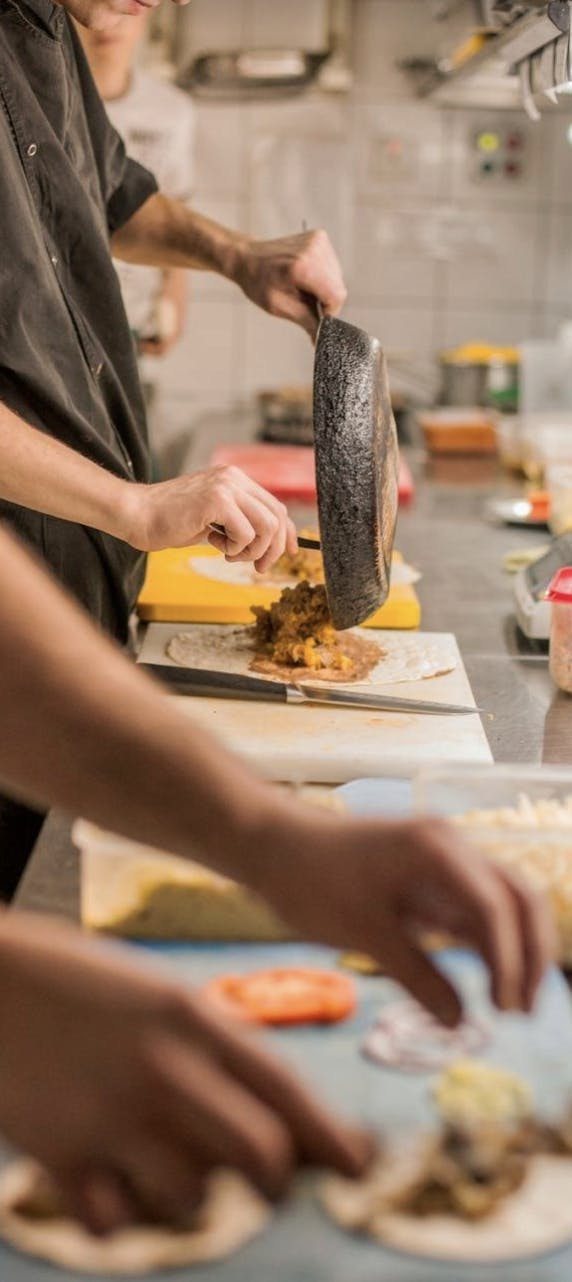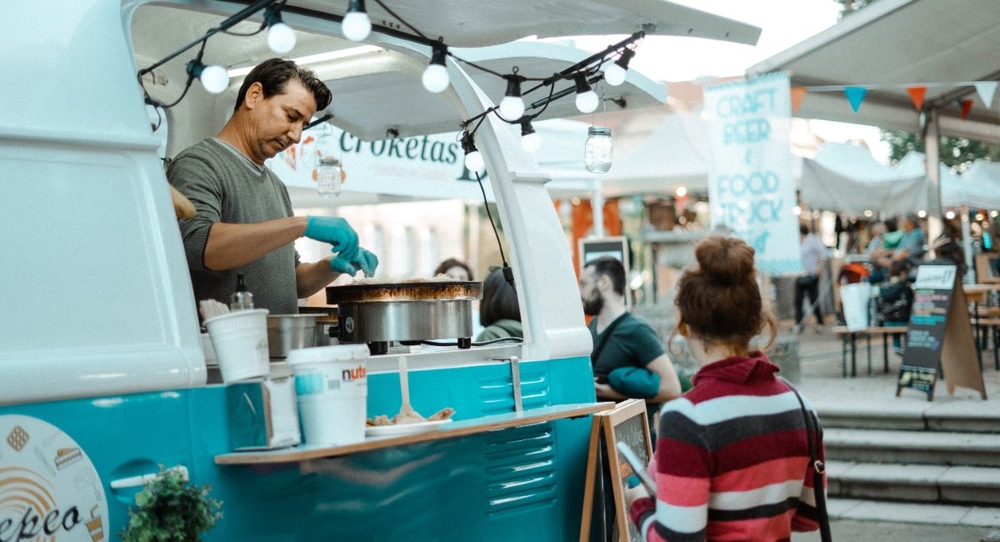Restaurant Catering Services: everything you need to start your own business
Table of Contents
CloudKitchens
How many tacos can be delivered from a 1000sqft restaurant?
The same amount as a 200sqft ghost kitchen.
Do you have a restaurant and want to grow your business with catering services? Or you want to start from scratch a restaurant catering service? It is important to know every step to avoid mistakes and reach the success you want.
A restaurant catering service means that a restaurant provides food and beverages for events, such as weddings, corporate functions, parties, and other gatherings.
We will guide you through what is a restaurant catering service, types of catering, profitability of this market and much more. Check it out!
What is restaurant catering?
Restaurant catering is a restaurant that starts to provide food and beverage services for events and gatherings outside of the restaurant’s physical location. It is a service that provides all the necessary food supplies for any event or institution like schools, hospitals, companies and more. In the catering service, the food is usually prepared at the catering company’s facilities and is delivered and served at the event location.
In addition, the restaurant that offers catering services is also responsible for all the equipment, logistics, cleaning and labor for the event, dealing with bureaucratic matters such as negotiating with suppliers and all the planning.
Catering allows restaurants to expand their reach by offering culinary expertise to clients in different ways beyond a traditional dining experience, for example.
Types of Catering Services
There are some types of catering services that are more common than others. Some of the most common are parties in general, weddings, and corporate events. But here, we will also talk about which menu services are typically offered by catering restaurants!
Normally, the restaurant catering includes:
- Weddings
- Birthday Parties
- Corporate Events
- Conferences
- In hospitals
- In schools
- Holiday Gatherings
- And so on!
Now, check what is included in the services:
Menu customization
- Customized Menus: Tailored to the event, dietary restrictions, and preferences.
- Tasting Sessions: Allowing clients to sample the menu before the event.
Service Staff
- Waitstaff: Servers who deliver food and beverages to guests.
- Bartenders: If alcohol is served, bartenders are usually provided to prepare and serve drinks.
- Chefs: On-site chefs for live cooking or specific dishes that require immediate preparation.
- Clean-up Crew: Staff responsible for clearing tables, disposing of waste, and tidying the venue after the event.
Equipment and Rentals
- Tables and Chairs: If the venue doesn’t provide them.
- Linens and Tableware: Including special linens, dishes, and glassware.
- Serving Equipment: Such as chafing dishes, trays, and serving utensils.
Beverage Service
- Alcoholic Beverages: Including wine, beer, cocktails, and spirits.
- Non-Alcoholic Beverages: Such as soft drinks, juices, tea, and coffee.
- Bartending Services: Professional bartenders to mix and serve drinks.
Logistics and Coordination
- Delivery: Transporting food and equipment to the venue.
- Setup: Arranging tables, chairs, and food stations.
- Cleanup: Post-event cleaning, including dishwashing and trash removal.
Special Requests
- Dietary Accommodations: Options for vegan, gluten-free, or other specific diets.
- Themed Menus: Catering to specific themes or cultural cuisines.
- Interactive Stations: Like carving stations, sushi bars, or dessert stations.
Additional Services
- Cake Cutting: If a wedding or special cake is provided.
- Takeaway Boxes: For guests to take home leftovers.
- Event Planning Assistance: Some caterers offer broader event planning services, including vendor coordination.
These services can often be customized depending on the event type, size, and specific needs!
Read More: 5 Commercial Kitchen Layouts & Designs
How profitable is a catering business?
The profitability of a catering restaurant depends on the type of event, and other factors such as menu selection, location, the event size and additional services. It’s important to have it in mind first of all so you’re able to plan everything very well before you offer this service.
For example, a small-to-medium-sized catering business could generate annual revenues ranging from $250,000 to over $1 million, with profits depending on the factors. Larger, more established catering restaurant businesses can earn several million in revenue with proportionally higher profits. But mind thef the profitability:
- Economic Downturns: Economic slowdowns can reduce disposable income, affecting the demand for catering services.
- Rising Costs: Increases in food, labor, and transportation costs can squeeze margins if not managed carefully.
- Event Cancellations: Unforeseen cancellations, mainly from customers, or any other factors. There needs to be a cancellation policy in the business.
A well-managed catering business with effective cost control, a solid pricing strategy, and a focus on high-demand markets can be very profitable. However, success requires careful planning, efficient operations, and a strong understanding of the target market.
Read more: Ghost Kitchen vs. Traditional Restaurant: Which Is Better?
Everything about restaurant catering for a start
Starting a catering business involves several steps, from planning and preparation to execution and management.
When you want to start a business, a good structure, whether it’s the environment or support, and a price that fits your budget is essential for any entrepreneur who wants a business to be successful.
At CloudKitchens, we have solutions designed for food entrepreneurs and seasoned chefs aiming to enhance their catering operations with a commercial or catering kitchen with all the licenses and permits. Our facilities are ideal for any catering business seeking to expand its service area or scale up operations. You can check our solutions here!
If you are curious about what you need to start a catering business or optimize the process, check our guide!
Market Analysis and Target Audience
First, you need to understand the competitors, the market of restaurant catering and so on. Here’s what you can do:
- Market Research: Analyze the demand for catering services in your area, including the types of events (weddings, corporate events, parties) that require catering.
- Identify Competitors: Study your competitors to understand their offerings, pricing, and customer service. Identify gaps in the market that you can fill.
- Target Audience: Define your target market (corporate clients, private events, weddings? Everything?) and tailor your services to meet their needs.
Structure a Business Plan for Your Catering Service
Next, you’ll need to figure out how to create an effective business plan for your new service. Your plan should incorporate everything you learned from your market analysis and, most importantly, accurately account for all the costs of your restaurant catering business.
Also, don’t forget to look into all the licenses and permits you’ll need to operate, including the costs for getting them.
- Business Plan: Create a detailed business plan that includes your mission, vision, goals, target market, marketing strategy, pricing, and financial projections.
- Licenses, Permits and Insurance: Obtain the necessary business licenses, food handling permits, and health department approvals. This may include liability insurance and alcohol licenses if you plan to serve alcoholic beverages. Also, purchase liability insurance to protect your business. You will need to protect your catering business!
Develop and Market Your Restaurant’s Catering Service
Now, you can start your restaurant catering through savings, loans, or investors to cover initial costs such as equipment, marketing, and inventory.This means you’ll need to put together your catering menu, set your prices, and figure out how to get the word out about your new service.
A great strategy is to host tasting sessions. This gives people a chance to try your food and see the quality for themselves. Once they’re convinced, it’s much easier to get them to book your service and spread the word through positive reviews and referrals.
And when you’re setting prices, be sure to keep your target audience in mind, but always make sure they’re in line with your business costs.
- Menu Design: Develop a menu that reflects your restaurant’s culinary style. Include a variety of options that cater to different tastes and different events!
- Pricing Strategy: Set competitive prices that cover food costs, labor, and overhead while ensuring profitability. Consider offering tiered pricing for different levels of service and sizes of events.
- Tasting Sessions: Offer potential clients the opportunity to taste your dishes before they commit, which can help more secure bookings.
Invest in Equipment and Vehicles for Food Transport
You have the basics for your restaurant now. So, next time you will need the equipment and staff which will be your safeguards.
- Kitchen Equipment: Depending on your setup, you may need commercial-grade ovens, refrigerators, mixers, and utensils. If you operate from your restaurant, leverage existing equipment.
- Transportation: Ensure you have reliable vehicles for transporting food, equipment, and staff to events.
Build and Train Your Team
No matter how great your catering equipment is, it won’t make the food on its own. You need to hire people for the job, and it’s even more important to make sure they have the right skills to deliver a high-quality service.
Also, be sure to consistently invest in training for your team. This will not only boost their skills but also improve productivity and the overall quality of your work.
- Hiring and Training: Recruit chefs, kitchen staff, waitstaff, and event coordinators. Depending on the event size, you may need temporary or part-time staff. Train your team in food safety, presentation, customer service, and event management.
Getting Your First Catering Event Organized
With your menu set, equipment ready, and licenses in place, after a few meetings with interested clients, you’ll achieve your biggest goal: your very first customer.
You’ve closed the contract, and the client has paid the price you so carefully determined. Now for the key part: preparing and organizing your first event.
Naturally, your entire catering service was built for this, but it’s completely normal to feel some doubts and uncertainties the first time you do it.
Ready to start your first event? Here’s what you need to have in mind:
- Event Coordination: Develop a process for managing events, from initial client consultations to post-event follow-ups. This includes timeline management, logistics, and client communication.
- Inventory Management: Keep track of ingredients, supplies, and equipment to avoid shortages or overstocking.
- Quality Control: Implement strict quality control measures to ensure consistency and high standards at every event.
- Budgeting: Create a budget to track your income and expenses. This includes food costs, labor, equipment, and marketing.
- Cost Control: Monitor food costs, waste, and labor efficiency to maximize profitability.
- Invoicing: Implement a clear invoicing and payment system to ensure timely payments from clients.
- Preparation: Plan each event meticulously, including menu preparation, equipment setup, and staffing.
- On-site Management: Ensure that food is prepared and served on time, staff is attentive, and the event runs smoothly.
- Post-Event: Handle cleanup, breakdown, and follow-up with clients for feedback and future bookings.
What to Do After a Big Event?
Your event was a great success! But to continue it and make the success you dream about with your restaurant catering, you also need some help to grow and expand your business in the future. So, what’s important to have in mind?
- Branding: You will need to develop a strong brand identity with a memorable logo, website, and social media presence.
- Networking: Build relationships with event planners, venues, and corporate clients who can refer your services.
- Online Presence: Create a website with detailed information about your services, menus, and contact information. Utilize social media and online reviews to attract more clients.
- Promotions: Offer discounts, special packages, or seasonal promotions to attract new clients.
- Client Retention: Focus on delivering exceptional service to encourage repeat business and referrals.
- Scaling: As your business grows, consider expanding your team, investing in more equipment, or opening additional locations.
In addition to all this, you can also start a business with all this already structured. With security and ample storage, where you can focus on food production efficiently and have everything detailed, CloudKitchens has everything you need for your catering business.
This way, you save time and money and have the construction, customization, permitting, and vendor coordination into one strong support offering from our team. Take a look at what we can offer!
How to create a menu for catering
Creating a catering menu involves more than just selecting dishes: it requires careful consideration of your target audience, event types, and operational capabilities. So, for this important part of your journey of creating a restaurant catering menu, you will need to think in some details, such as:
| Understand Your Audience | Determine who you are catering to: corporate clients, wedding parties, private events, etc. This will influence the style and variety of your menu. |
| Consider Seasonality | Regularly update your menu to reflect seasonal changes. This keeps your offerings fresh and can attract repeat clients! |
| Balance and Variety | You can do flavor profiles (sweet, savory, spicy and so on) for your menu, plus dietary options! |
| Portion Sizes | You can adjust the portion sizes based on the event and style of your client and consider how to handle leftovers. |
| Pricing Strategy | Calculate costs of each menu item to ensure profitability. You also can think of packages (basic, premium, for example) and also include a set number of appetizers, entrees and so on! |
| Testing and Feedback | Make adjustments based on feedback from staff or trusted clients. After events, gather feedback from clients and make the necessary adjustments. |
By carefully planning and balancing these elements, you can create a catering menu that is both appealing to clients and profitable for your business.
Which business model is more profitable, a catering business or a restaurant?
The profitability of a catering business versus a restaurant depends on several factors, including market conditions, location, target audience, and operational efficiency. However, both models have distinct advantages and challenges that can impact profitability.
How do you attract catering customers?
Attracting catering customers involves a combination of effective marketing, networking, and delivering exceptional service. Check some basic needs to attract customers!
- Partner with Venues: Establish connections with venues that regularly host events.
- Engage Locally: Use word-of-mouth marketing by participating in community events.
- Leverage Social Media: Build a strong digital presence and post engaging content.
- Optimize SEO: Ensure your website ranks well in search engines for your website and also for Local SEO.
- Utilize Directories: List your business on web directories like Google My Business.
- Referral Programs: Reward customers for referrals. It’s a good way to have the fidelity of clients.
- Stay Connected: Maintain relationships with past clients. They can help your brand to have referrals, for example. You can send newsletters, rewards programs, catering tips and so on!
Attracting new catering clients is crucial for sustaining your business, but also is necessary for your restaurant catering business to have a good kitchen located in central areas like Tempe, so you can reach your customer base better.
CloudKitchen is an ideal solution for entrepreneurs looking for a kitchen for catering. With well-equipped spaces and strategic locations, CloudKitchen gives you the opportunity to operate high-quality catering businesses. Discover all the solutions we can offer!
DISCLAIMER: This information is provided for general informational purposes only and the content does not constitute an endorsement. CloudKitchens does not warrant the accuracy or completeness of any information, text, images/graphics, links, or other content contained within the blog content. We recommend that you consult with financial, legal, and business professionals for advice specific to your situation.
More insights & stories
There’s more where that came from.
Get in the know and check out our additional insights


